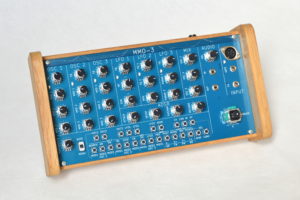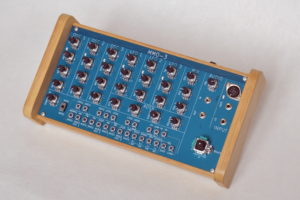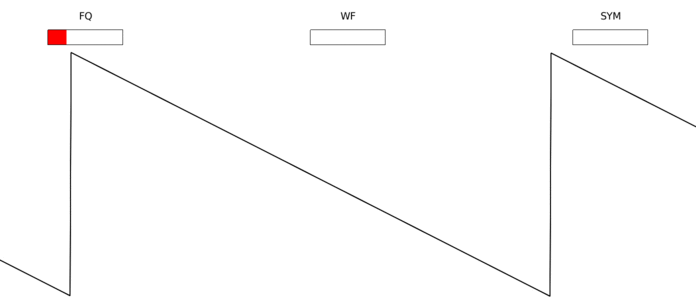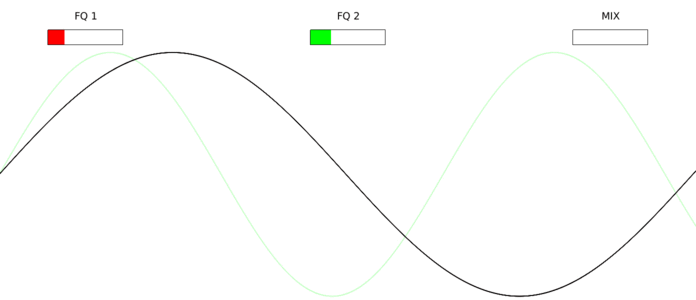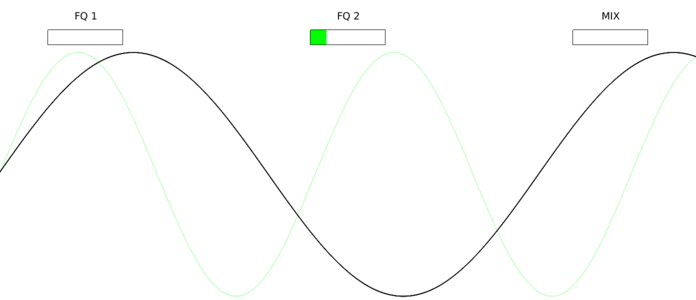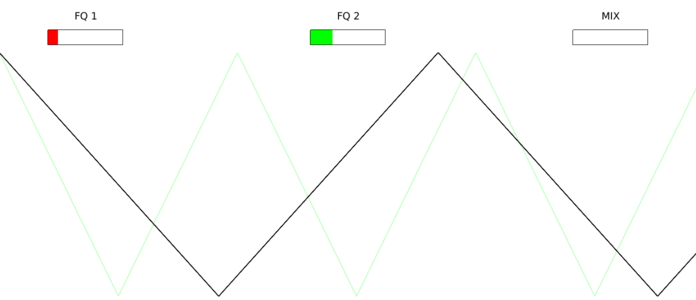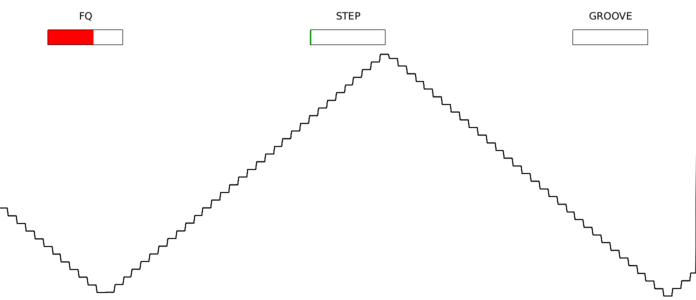MMO-3 is a digital, semi-modular, monophonic but stereo synthesizer. Built around various types of modulation synthesis (AM, FM, PM, WS), this synthesizer is mostly dedicated to atonal sound generation. From fat drones, glitchy electronic patterns or percussive noise, the MMO-3 offers rich and complex timbre control.
Overview
Unlike most FM synthesizers, the MMO-3 is not limited to a specific modulation routing. All 3 oscillators can be modulated by all other oscillators or LFOs. Modulation parameters are accessible thanks to 9 knobs for an accurate and continuous adjustment of the timbre.
Moreover, it’s not only a FM synth : it also offers Phase Modulation, Amplitude Modulation and a custom Wave Shaper modulation technique where an oscillator amplitude can be amplified prior to a wave-shaper in order to add harmonics without frequency variation.
Also, a joystick allows for easy manipulation of modulations, for a fast and expressive control of the sound.
What is inside?
- 30 control knobs
- A joystick to control modulation parameters
- 3 oscillators
- FM, AM, PM and Wave Shaping modulation
- 3 LFOs with complex waveform
- 1 ADSR
- 1 MIX (3 channels, stereo)
- 1 dual VCA
- 1 dual distortion
- A very powerful digital connection matrix to control oscillator modulations
- 2 octaves keyboard with portamento
- 1 Stereo audio line IN
- 1 Stereo audio line OUT
- 1 MIDI input (note / velocity / pitch wheel / control change)
- 1 analog CV IN and 1 GATE IN
Users comments
- “Lot’s of fun with the MMO-3! I love the FM tones you can get out of this” Richard Devine
- “Exactly what I was searching for” Jean Michel Jarre
- “Digital Synthesis Refreshingly Different!” Synthanathomy
- “An incomparable performing pleasure” Wilfried Wendling
- “This thing is pretty fucking wild” Nelson Baboon
- “A very complex and very rich machine” DJ Claim
Audio routing
Oscillators
The 3 oscillators are identical. They generate sinusoidal waveforms, that can be distorted thanks to 4 different kinds of modulation. The amplitude, frequency, phase or waveform of each oscillator can be modulated using any modulation source.
Amplitude modulation
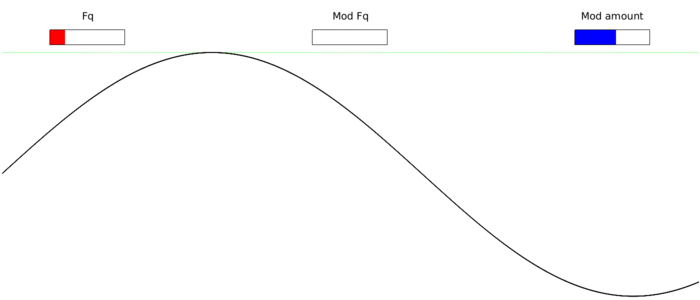
Frequency modulation
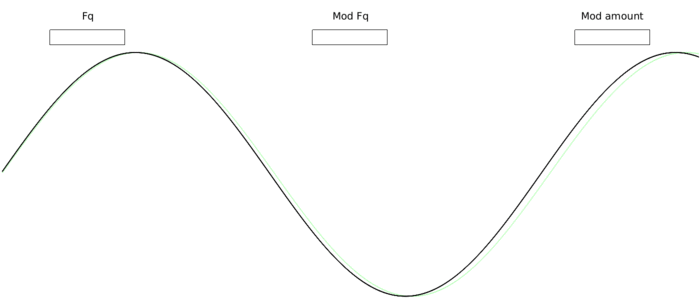
Phase modulation
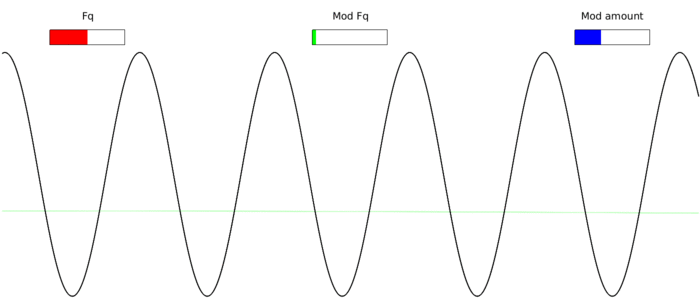
Wave shaper modulation
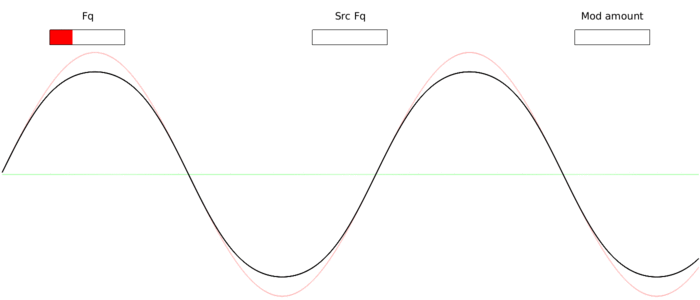
Auto modulation and feedback loop
Using the modulation matrix, it is possible to create auto-modulation, or feedback loop.

In association with phase modulation, auto-modulation creates digital instabilities resulting in high pitch noise.
Using a more complex modulation routing admitting a feedback loop, the phase modulation or the wave shaper modulation could generate unexpected glitchy results.
LFO
The MMO-3 has 3 LFOs.
They generate very complex wave-shapes, within huge frequency range (from about 0.01Hz to 100Hz).
- LFO 1 is a shape morphing between triangle, saw, sinus, square and pulse
- LFO 2 is an amplitude modulation of 2 sinusoid
- LFO 3 can be one of these 5 LFO :
Shape morphing (LFO1 and LFO3)
Amplitude modulation (LFO2 and LFO3)
Frequency modulation (LFO3)
Triangles (LFO3)
Steps (LFO3)
ADSR

This is a standard analogue ADSR :
Attack, Decay and Release times, and Sustain amplitude can be adjusted with potentiometers. The ADSR also generates a signal that can be used in the modulation matrix.
It has three different functions depending on the GATE mode:
- KB: ADSR controls the sound amplitude. It is triggered by the keyboard, the external GATE CV or by pushing in the joystick switch.
- LFO3: ADSR controls the sound amplitude. It is triggered when the LFO3 is positive.
- ON: The sound amplitude is constant. ADSR signals can be triggered as in KB mode but are only used for the modulation matrix
MIX
The 3 MIX potentiometers allow independent adjustments of the oscillators amplitude. The MIX have 3 options for stereo balance :
- MONO : all 3 oscillators are mixed in the same way on both right and left channel.
- MIX : the oscillator 1 is louder in the left channel, the oscillator 3 is louder in the right channel, the oscillator 2 is in the center.
- STEREO : the oscillator 1 is only in the left channel, the 3 is only on the right, and the 2 is in the center.
The MIX output passes through a distortion, generating harmonics depending on the MIX amplitude.
VCA
The dual VCA is controlled by the ADSR. Its position in the audio chain can be changed to be before or after the distortion, thanks to the ADSR “PRE” or “POST” option.
Keyboard

When toggle is on NOTE, this is a 2 octaves keyboard controlling the frequencies of the VCOs. The portamento filters the frequency change of the keyboard.
When toggle is on MENU, the keyboard is used to patch the matrix and to edit options.
Joystick
The joystick allows to mix 4 modulation signals to create a new modulation. For every direction (UP, Down, Left, Right), a modulation source is selected. The joystick mixes these 4 modulations depending on its position. The output can be used like any other modulation.
Digital patching matrix
Modulation connections are made via a digital matrix. The Matrix allows to connect any CV to any modulation potentiometer. You will not be short of cables anymore, and you can even save your patch!
Control Voltages are :
- OSC 1
- OSC 2
- OSC 3
- LFO 1
- LFO 2
- LFO 3
- ADSR
- Audio In (left or right)
- EXTERNAL CV 1 (or MIDI pitch Bend)
- Joystick (XY)
Modulation potentiometers are :
- OSC 1 MOD 1
- OSC 1 MOD 2
- OSC 1 MOD 3
- OSC 2 MOD 1
- OSC 2 MOD 2
- OSC 2 MOD 3
- OSC 3 MOD 1
- OSC 3 MOD 2
- OSC 3 MOD 3
- Joystick X-
- Joystick X+
- Joystick Y-
- Joystick Y+
MIDI
You can also control your synthesizer with a MIDI cable : using a keyboard to play notes, or the pitch bend to control the sound. You can also connect an external sequencer, a computer etc. The midi data used are :
- Note On / Note Off
- Pitch bend. When sending Pitch bend value, the CV IN 1 is disconnected from the analog input and connected to this midi data.
- Program change from 1 to 10 – channel 1 : load one of the memory.
- Control Change (1CC – 7 bits / 2CC – 14 bits) : control all potentiometers in midi. Midi data is added to the potentiometer value to control the corresponding parameter. For 14 bits MIDI, use CC N for MSB, and CC N+32 for LSB. Always send MSB after the LSB.
Audio in
The audio in signal can be used in 2 different ways.
- An envelop follower connected to the left input can generate gate signals in order to easily synchronize the MMO-3 to an other sound machine.
- The audio signal can be used as a modulation source for the oscillators or the joystick. the “AUDIO IN” modulation source is in fact 2 sources : the left and right signals. When the audio in is selected to control the oscillator 1, joystick X- or Y- : the left channel is used. The right channel is used to modulate the oscillator 3, joystick X+ and Y+. The left and right average is used to modulate oscillator 2.
External CV
1 analog input (-6v/6V) and an external GATE IN (0/5V) are available using 3.5 mono jacks, compatible with most modular setups.
Specifications
- 30 potentiometers, 12 bits input
- 44.1KHz audio synthesis
- about 10KHz for CV computation (modulations are at audio rate)
- 24 bits audio ADC and DAC
- 32 bits audio synthesis
- 12 bits ADC for the potentiometers and CV in
- about 80 dB S/N for the audio line-out
- 0.5 ms IN/OUT audio latency
- cortex M3 32 bits micro-controller (from an arduino due)
- 9 to 12V DC power supply (1 standard 2.1mm power plug or 1 standard eurorack plug)
- low power consumption (300mA @ 12V)
- eurorack compatible (3U, 10 inches : 50HP)
- 280 x 150 x 60mm wood (oak) box
- about 620g
Documentation
Preset pages
MMO-3_preset_page_A4
MMO-3_preset_page_A5
MMO-3_preset_page_A6

